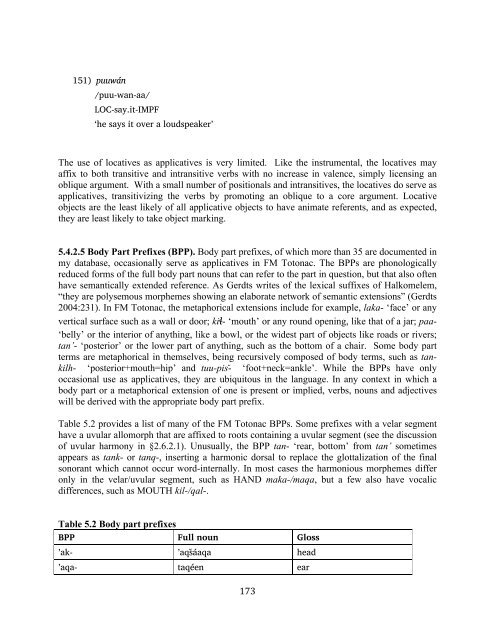The phonology and morphology of Filomeno Mata Totonac
The phonology and morphology of Filomeno Mata Totonac
The phonology and morphology of Filomeno Mata Totonac
You also want an ePaper? Increase the reach of your titles
YUMPU automatically turns print PDFs into web optimized ePapers that Google loves.
151) puuwán<br />
/puu-wan-aa/<br />
LOC-say.it-IMPF<br />
‘he says it over a loudspeaker’<br />
<strong>The</strong> use <strong>of</strong> locatives as applicatives is very limited. Like the instrumental, the locatives may<br />
affix to both transitive <strong>and</strong> intransitive verbs with no increase in valence, simply licensing an<br />
oblique argument. With a small number <strong>of</strong> positionals <strong>and</strong> intransitives, the locatives do serve as<br />
applicatives, transitivizing the verbs by promoting an oblique to a core argument. Locative<br />
objects are the least likely <strong>of</strong> all applicative objects to have animate referents, <strong>and</strong> as expected,<br />
they are least likely to take object marking.<br />
5.4.2.5 Body Part Prefixes (BPP). Body part prefixes, <strong>of</strong> which more than 35 are documented in<br />
my database, occasionally serve as applicatives in FM <strong>Totonac</strong>. <strong>The</strong> BPPs are phonologically<br />
reduced forms <strong>of</strong> the full body part nouns that can refer to the part in question, but that also <strong>of</strong>ten<br />
have semantically extended reference. As Gerdts writes <strong>of</strong> the lexical suffixes <strong>of</strong> Halkomelem,<br />
“they are polysemous morphemes showing an elaborate network <strong>of</strong> semantic extensions” (Gerdts<br />
2004:231). In FM <strong>Totonac</strong>, the metaphorical extensions include for example, laka- ‘face’ or any<br />
vertical surface such as a wall or door; ki"- ‘mouth’ or any round opening, like that <strong>of</strong> a jar; paa-<br />
‘belly’ or the interior <strong>of</strong> anything, like a bowl, or the widest part <strong>of</strong> objects like roads or rivers;<br />
tan’- ‘posterior’ or the lower part <strong>of</strong> anything, such as the bottom <strong>of</strong> a chair. Some body part<br />
terms are metaphorical in themselves, being recursively composed <strong>of</strong> body terms, such as tankilh-<br />
‘posterior+mouth=hip’ <strong>and</strong> tuu-pis'- ‘foot+neck=ankle’. While the BPPs have only<br />
occasional use as applicatives, they are ubiquitous in the language. In any context in which a<br />
body part or a metaphorical extension <strong>of</strong> one is present or implied, verbs, nouns <strong>and</strong> adjectives<br />
will be derived with the appropriate body part prefix.<br />
Table 5.2 provides a list <strong>of</strong> many <strong>of</strong> the FM <strong>Totonac</strong> BPPs. Some prefixes with a velar segment<br />
have a uvular allomorph that are affixed to roots containing a uvular segment (see the discussion<br />
<strong>of</strong> uvular harmony in §2.6.2.1). Unusually, the BPP tan- ‘rear, bottom’ from tan’ sometimes<br />
appears as tank- or tanq-, inserting a harmonic dorsal to replace the glottalization <strong>of</strong> the final<br />
sonorant which cannot occur word-internally. In most cases the harmonious morphemes differ<br />
only in the velar/uvular segment, such as HAND maka-/maqa, but a few also have vocalic<br />
differences, such as MOUTH kil-/qal-.<br />
Table 5.2 Body part prefixes<br />
BPP Full noun Gloss<br />
’ak- ’aqs"áaqa head<br />
’aqa- taqéen ear<br />
! "+'!

















